|
|
|
Sort Order |
|
|
|
Items / Page
|
|
|
|
|
|
|
| Srl | Item |
| 1 |
ID:
148769
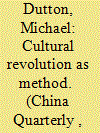

|
|
|
|
|
| Summary/Abstract |
This paper treats the Chinese Cultural Revolution as a means by which to open on to a more affective approach to the question of the political. It examines one piece of art-technology of that period and shows the way it intuitively worked within the fluidity of power to produce political intensity. This one technology is a microcosm of the Cultural Revolution notion of the political that was built around an attempt to channel and harness affective power towards revolutionary ends. Both because it attempts to direct the political through the affective dimension and because its methods of doing so resembled contemporary art practices, this paper opens on to the possibilities of a method based on an art rather than a science of the political.
|
|
|
|
|
|
|
|
|
|
|
|
|
|
|
|
| 2 |
ID:
170945
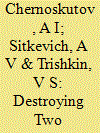

|
|
|
|
|
| Summary/Abstract |
The authors present a new method of destroying two heterogeneous groups by comparing their combat superiority coefficients. Examples demonstrate this method's efficiency and in certain cases, its application as the sole option of attaining victory
|
|
|
|
|
|
|
|
|
|
|
|
|
|
|
|
| 3 |
ID:
111375
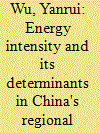

|
|
|
|
|
| Publication |
2012.
|
| Summary/Abstract |
This paper contributes to the existing literature as well as policy debates by examining energy intensity and its determinants in China's regional economies. The analysis is based on a comprehensive database of China's regional energy balance constructed for this project. Through its focus on regional China, this study extends the existing literature, which mainly covers nationwide studies. It is found in this paper that energy intensity declined substantially in China. The main contributing factor is the improvement in energy efficiency. Changes in the economic structure have so far affected energy intensity modestly. Thus there is considerable scope to reduce energy intensity through the structural transformation of the Chinese economy in the future.
|
|
|
|
|
|
|
|
|
|
|
|
|
|
|
|
| 4 |
ID:
161096
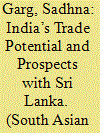

|
|
|
|
|
| Summary/Abstract |
Under the wave of regionalism, India like other developing countries started
to integrate at regional level. At the initial stage, it wanted to establish strong
trade relations with its neighbouring countries. It (India) signed its first free
trade agreement (FTA) with Sri Lanka in 1998, which became operational from
2000. Thereafter, bilateral trade continued to increase with increasing rate. It
is in this context, the present study attempts to explore India’s trade potential
and prospects with Sri Lanka, utilised revealed comparative advantage (RCA) and
trade intensity Index (TII). The results of RCA show that India has strong and
sustainable trade specialisation (RCA > 1) in the export of edible vegetables
and certain roots and tubers, coffee, tea mate and spices, cotton etc to Sri Lanka.
This comparative advantage helps not only to diversify product baskets, but also
lead to increased volume of trade. India has no comparative advantage in the
import of any product from Sri Lanka. India has intensity of trade with Sri Lanka
since 1991. India has sustainable trade potential and prospects with Sri Lanka and
been a net exporter to it. Efforts should be made to utilise this potential.
|
|
|
|
|
|
|
|
|
|
|
|
|
|
|
|
| 5 |
ID:
159051
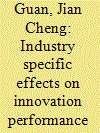

|
|
|
|
|
| Summary/Abstract |
This research aims to understand how industrial characteristics in Chinese industrial sectors are related to and affect innovation activities. Using Heckman's two-step procedure, this study contributes to examine firms' innovation determinants with a framework that clearly distinguishes between the two steps of innovation model: innovation propensity (probability of being innovative) and innovation performance (patents and innovation sales). In particular, the moderating effects of industrial characteristics on the relationships between R&D intensity, financial incentives and innovation performance are discussed. The findings show that different industrial characteristics generate different impacts on innovation propensity and innovation performance. Firms in capital intensive industries and relative monopoly industries are more likely to innovate. The findings also show that Direct Government Subsidy does not contribute significantly to improve economical innovation performance of firms and Indirect Government Subsidy on innovative economic performance is easier to be influenced by industry characteristics, which have important potential policy implications to guide innovation activities for Chinese policy makers as well as for Chinese firms.
|
|
|
|
|
|
|
|
|
|
|
|
|
|
|
|
| 6 |
ID:
188825
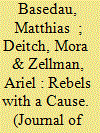

|
|
|
|
|
| Summary/Abstract |
Ideology may directly provide motive and indirectly capacity for collective violence, thus making armed conflicts longer and bloodier. We investigate these propositions by drawing on an innovative global dataset which codes ideological claims by rebel groups and governments in intrastate armed conflicts since 1946. Results demonstrate that although ideology increases conflict duration, these effects vary by type and timing. Whereas secular ideological conflicts tended to be more protracted during the Cold War, religious ideology has become increasingly important since. We, however, find little evidence that ideology increases conflict intensity. Rather, rebel criminality best accounts for intensity. So, while immaterial resources like ideology sustain willingness to fight, ideology’s influence upon conflict intensity is limited, especially after the Cold War. Future studies need to take ideology seriously and need to investigate its characteristics more in-depth and in conjunction with material, identity related and international variables.
|
|
|
|
|
|
|
|
|
|
|
|
|
|
|
|
| 7 |
ID:
110416


|
|
|
|
|
| Publication |
2011.
|
| Summary/Abstract |
This study develops and examines physical energy intensity indicators in five industrial sub-sectors-iron and steel, aluminum, textiles, paper, and cement-and investigates mitigation options for energy related CO2 emissions (during 1991-2005). Decomposition analysis has been employed to separate the structural effect (share of different products in the sector) from pure intensity effect (efficiency increase through technical improvement) for each industry. The results show that the combined effect (considering both structural and intensity effects together) on both iron and steel and paper and pulp industries is negative while it is positive for aluminum and textiles. The intensity effect for all the industries, barring textiles, is negative showing improvement in energy efficiency; iron and steel in particular, has seen a decrease of 134 PJ in energy consumption owing to improvements in efficiency. However, energy intensity in textiles has risen by 47 PJ due to increased mechanization. Structural effect is positive in aluminum and iron and steel industries indicating a movement towards higher energy-intensive products. In the case of aluminum, positive structural effect dominates over negative intensive effect whereas negative intensive effect dominates iron and steel industry. The paper helps in designing policies for improving productivity and reduce energy consumption in India's manufacturing sector.
|
|
|
|
|
|
|
|
|
|
|
|
|
|
|
|
|
|
|
|
|